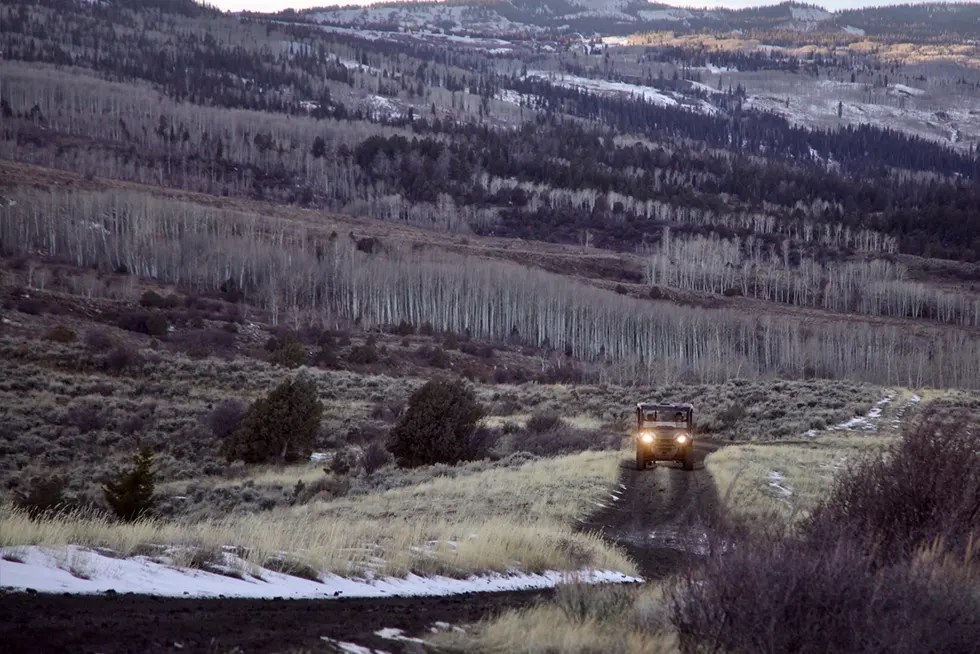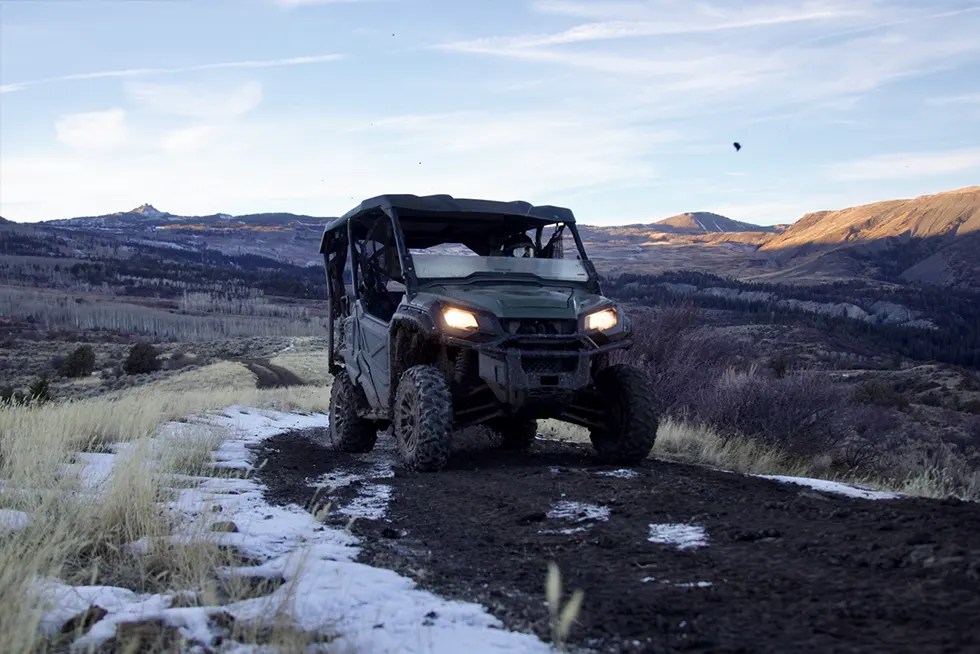ATV SAFETY TIPS: WHAT YOU NEED TO KNOW BEFORE HITTING THE VAIL TRAILS
ATV riding in Vail offers thrilling adventures in nature. At Sage Outdoor Adventures, we prioritize safety to ensure a fun and secure ride. Our expert guides and well-maintained equipment guarantee a safe experience. In this guide for ATV Safety Tips, we’ll cover all you need to know for a safe and exhilarating adventure in Vail.
Pre-Ride Preparation
Check Your ATV
Before you hit the trails, it’s essential to ensure that your ATV is in top condition. Begin with a thorough inspection of your vehicle. Check the tire pressure to avoid flats or blowouts, and make sure the brakes are functioning correctly for safe stopping power. Confirm that your fuel tank is full and that all lights and indicators are working. A quick walk-around can help you spot any visible issues that might need attention.
Wear Appropriate Safety Gear
Safety gear is your first line of defense against potential injuries. Always wear a DOT-approved helmet, as head injuries are the most common and severe in ATV accidents. Gloves can protect your hands from blisters and improve your grip, while protective clothing, such as long sleeves, long pants, and sturdy boots, can shield your skin from scrapes and the elements. Goggles are essential to protect your eyes from dust, debris, and insects.
Understanding the Terrain
Familiarize Yourself with the Vail Trails Map
 Before you set out, take the time to study the Vail trails map. Knowing the layout of the trails will help you plan your route and avoid getting lost. Pay attention to the difficulty levels of different trails and choose ones that match your skill level. Sage Outdoor Adventures provides detailed maps and can offer recommendations based on your experience and preferences.
Before you set out, take the time to study the Vail trails map. Knowing the layout of the trails will help you plan your route and avoid getting lost. Pay attention to the difficulty levels of different trails and choose ones that match your skill level. Sage Outdoor Adventures provides detailed maps and can offer recommendations based on your experience and preferences.
Identify Potential Hazards
The Vail trails offer a diverse range of terrains, from rocky paths and muddy stretches to steep inclines and dense forests. Being aware of these potential hazards can help you navigate them safely.
Understand Weather Conditions
Weather can significantly impact the safety and enjoyment of your ATV ride. Check the weather forecast before you head out and be prepared for sudden changes. Rain can make trails slippery and challenging, while extreme heat can cause dehydration and fatigue. Dress appropriately for the weather and bring extra layers or rain gear if needed.
Riding Techniques
Basic Riding Positions
Mastering the basic riding positions is crucial for maintaining control and balance on your ATV. Here are the primary positions you’ll use:
- Seated Position: This is the most common position, especially on flat or gently rolling terrain. Sit firmly with your feet on the footrests, knees slightly bent, and hands gripping the handlebars. Keep your back straight and lean slightly forward to maintain balance.
- Standing Position: When navigating rough or uneven terrain, standing up on the footrests can improve your control and visibility. Keep your knees bent and your body loose to absorb shocks from the ground.
- Leaning: When taking turns or riding on slopes, leaning your body in the direction of the turn or slope helps maintain balance and prevents tipping. For sharp turns, shift your weight to the inside footrest and lean into the turn.
Techniques for Different Terrains
The Vail trails offer a variety of terrains, each requiring specific riding techniques to navigate safely.
- Uphill Riding: Approach hills at a steady speed and maintain momentum. Lean forward and shift your weight to the front of the ATV to prevent it from tipping backward. Avoid sudden accelerations or stops.
- Downhill Riding: When descending, reduce your speed and shift your weight to the rear of the ATV. Use the brakes gently and avoid locking them up, which can cause you to lose control.
- Uneven Surfaces: On rocky or bumpy trails, keep a firm grip on the handlebars and stand on the footrests to allow your legs to act as shock absorbers. Maintain a slow, steady speed to navigate obstacles safely.
Importance of Maintaining a Safe Speed and Distance
Speed control is vital for ATV safety. Always ride at a speed that allows you to react to unexpected obstacles or changes in the terrain. Avoid riding too fast, especially in unfamiliar areas or on difficult trails.
Maintaining a safe distance between you and other riders is equally important. This buffer zone gives you time to react to sudden stops or changes in direction by the rider ahead. It also reduces the risk of collisions.
Emergency Procedures
What to Do in Case of a Breakdown or Accident
Even with the best preparation, unexpected situations can arise. Knowing how to handle a breakdown or accident is crucial for your safety and the safety of others.
- Breakdown Procedures: If your ATV breaks down, move it to the side of the trail if possible. Use reflective markers or hazard lights to signal to other riders that you need assistance. Check your vehicle for any obvious issues, such as loose connections or flat tires, and attempt basic repairs if you have the tools and knowledge.
- Accident Response: In the event of an accident, assess the situation calmly. Check yourself and others for injuries. If anyone is hurt, do not attempt to move them unless they are in immediate danger. Call emergency services or use a satellite phone if you’re in an area with no cell reception.
How to Call for Help and Signal Your Location
Having a reliable means of communication is vital when riding in remote areas. Here are some tips on how to call for help and signal your location effectively:
- Communication Devices: Carry a fully charged cell phone, a portable charger, and a satellite phone or two-way radio for areas with no cell service. Know the local emergency numbers and have them saved in your contacts.
- Signaling Devices: Use flares, a whistle, or an emergency beacon to signal your location if you’re unable to call for help. Reflective materials and brightly colored clothing can also make you more visible to search and rescue teams.
- Informing Others: Always ride with a buddy or inform someone of your planned route and expected return time. This ensures that someone knows where you are and can raise the alarm if you don’t return as expected.
Basic First Aid Steps for Common ATV Injuries
Accidents can happen, so it’s essential to be prepared to administer basic first aid until professional help arrives. Here are some steps for common ATV injuries:
- Cuts and Scrapes: Clean the wound with water and apply antiseptic. Cover with a sterile bandage to prevent infection.
- Sprains and Strains: Rest the injured area and apply ice to reduce swelling. Elevate the limb and use a compression bandage if available.
- Fractures: Immobilize the injured limb using a splint or any available rigid material. Avoid moving the person unnecessarily and seek professional medical help immediately.
- Heat Exhaustion: Move to a shaded area, hydrate with water or electrolyte drinks, and cool the person with wet cloths. If symptoms persist, seek medical attention.
Family-Friendly ATV Riding
Tips for Riding with Children and Ensuring Their Safety
 Riding ATVs can be a fun family activity, but it’s essential to take extra precautions when children are involved. Here are some tips to keep your little ones safe and ensure a great experience for everyone:
Riding ATVs can be a fun family activity, but it’s essential to take extra precautions when children are involved. Here are some tips to keep your little ones safe and ensure a great experience for everyone:
- Age-Appropriate Vehicles: Ensure that children ride age-appropriate ATVs. Youth ATVs are designed with lower speeds and easier handling to suit young riders.
- Proper Gear: Make sure children wear the same protective gear as adults, including helmets, gloves, goggles, and protective clothing. Gear should fit properly and be comfortable.
- Supervision: Always supervise children closely when they are riding. Stay within a safe distance to provide guidance and assistance if needed.
- Training: Before hitting the trails, teach children the basics of ATV operation and safety. Consider enrolling them in a formal ATV safety course tailored for young riders.
Choosing Kid-Friendly Trails and Rides
Selecting the right trails can make a significant difference in the enjoyment and safety of your family’s ATV adventure. Look for trails that are:
- Beginner-Friendly: Opt for trails with gentle slopes, minimal obstacles, and smooth surfaces. Avoid trails that are too steep or rugged for young riders.
- Shorter in Length: Choose shorter routes that match your children’s endurance levels. Frequent breaks can help keep them energized and engaged.
- Scenic and Educational: Trails that offer interesting sights and learning opportunities can make the ride more enjoyable for kids. Point out wildlife, plants, and geological features along the way.
Safety Tips Recap
Don’t forget this: Riding ATVs on the amazing Vail trails is super exciting and a cool way to explore the great outdoors. But, staying safe is really important for a great adventure. From getting ready before you ride and knowing the different terrain to learning the right riding techniques and following local rules, every little thing you do helps make your journey safer and more fun.
Being ready for emergencies and following the best practices means you can handle unexpected situations with confidence. Riding with family, especially kids, makes the experience even better, as long as you take the right steps to keep everyone safe.
We invite you to visit Sage Outdoor Adventures for guided ATV tours, expert advice, and an unforgettable experience on the Vail trails. Our team is here to support you in making your adventure both safe and exhilarating. Happy riding!

Nick Junker
General Manager
I’m dedicated to leveraging my skills and experiences to make a positive impact in the professional realm.
With a background in Sales and Outdoor Recreation, I’ve navigated through various roles where I’ve honed my expertise in Risk Management, Business Development and Financial Analysis. From Account Executive to General Manager, I’ve cultivated a deep understanding of client and employee relations, Human Resources, Project Management and overall business operations from generating sales to budgeting expenses and managing over 30 employees.
My mission is to create a great culture in any organization I am apart of, through creating efficient industry specific systems within the business that satisfies both employees and investors. Whether it’s through implementing new business systems or managing employee expectations, I’m committed to meeting the goals of the organization.
Known for my strong leadership and organizational skills, I excel in delegating tasks to keep projects and goals on task and on budget. I’m passionate about systems, always seeking innovative solutions to making the business run smoother and more efficiently. I believe in the power of collaboration and enjoy working with diverse individuals to build a strong team thats driven to accomplish the organizations goals.

